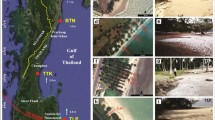Abstract
Hurricane Andrew, one of the strongest storms of the century, crossed the southern part of the Florida peninsula on 24 August 1992. Its path crossed the Florida Everglades and exited in the national park across a mangrove-dominated coast onto the shallow, low-energy, inner shelf. The storm caused extensive breakage and defoliation in the mangrove community; full recovery will take decades. It produced no extensive sedimentation unit; only local and ephemeral ebb-surge deposits. The discontinuous shelly storm beach ridge was breached at multiple locations, and it moved landward a few meters. After seven months, there was little geologic indication that the storm had passed. It is likely that the stratigraphic record in this area will not contain any recognizable features of the passage of Hurricane Andrew.
Similar content being viewed by others
References
Aigner T (1985) Storm depositional systems. New York: Springer-Verlag, Lecture Notes in Earth Science No. 3
Boss SK and Neumann AC (1993) Impacts of Hurricane Andrew on carbonate platform environments, northern Great Bahama Banks. Geology 20:897–900
Davis RA, Fingleton WG, Allen GR, Crealese CD, Johanns WM, O'Sullivan JA, Reive CL, Scheetz SJ, and Stranaly GL (1973) Corpus Christi Pass: A hurricane modified tidal inlet on Mustang Island, Texas. Contrib Mar Sci 17:123–131
Davis RA, Jewell P, and Sussko RJ (1989) Inner continental shelf off southwest Florida. In: Morton RA and Nummedal D (Eds), Shelf sedimentation, shelf sequences and related hydrocarbon accumulation. Proceedings, 7th Annual Research Conference, Gulf Coast Section-SEPM. pp 53–62
Davis RA, Jewell P, and Klay, J (1993) Sedimentology and stratigraphy of tidal sand ridges, southwest Florida inner shelf. J Sediment Petrol 63:91–104
Dawes CJ, Bell SS, Davis RA, McCoy ED, Mushinsky HR, and Simon JS (1995) Initial effects of Hurricane Andrew on the shoreline habitats of southwestern Florida. J Coast Res (in press)
Hayes MO (1967) Hurricanes as geologic agents; case studies of Hurricane Carla, 1961 and Cindy, 1963. University of Texas Bureau of Economic Geology, Report Investigation No. 61
Morton RA (1981) Formation of storm deposits by wind-forced currents in the Gulf of Mexico and the North Sea. In: Nio SD and others (Eds), Holocene marine sedimentation in the North Sea Basin. International Association of Sedimentation, Special Publication No 5. pp 385–396
Perkins RD and Enos P (1968) Hurricane Betsy in the Florida-Bahama area—geologic effects and comparison with Hurricane Donna. J Geol 76:710–717
Rappaport EN and Sheets RC (1993) A meteorological analysis of Hurricane Andrew. In: The state of the art of beach nourishment. Proceedings, 6th Annual National Conference on Beach Preservation Techniques, Florida Shore & Beach Preservation Association, pp 340–357
Schmidt DV and Clark R (1993) Impacts of Hurricane Andrew on the beaches of Florida. In: The state of the art of beach nourishment. Proceedings, 6th Annual National Conference on Beach Preservation Techniques, Florida Shore & Beach Preservation Association. pp 279–309
Snedden JW and Nummedal D (1989) Sand transport kinematics on the Texas continental shelf. In: Morton RA and Nummedal D (Eds), Shelf sedimentation, shelf sequences and related hydrocarbon accumulation. Proceedings, 7th Annual Research Conference, Gulf Coast Section-SEPM. pp 63–76
Snedden JW, Nummedal D, and Amos AF (1988) Storm and fairweather combined-flow on the central Texas continental shelf. J Sediment Petrol 58:580–595
Sussko RJ and Davis RA (1992) Sedimentology of the siliciclastic to carbonate transition on the southwest Florida inner shelf. Mar Geol 107:51–60
Swift DJP, Thorne JS, and Oertel GF (1986) Fluid processes and sea-floor response on a modern storm-dominated shelf: Middle Atlantic shelf of North America. Part II: response of the shelf floor. In: Knight RJ and McLean JF (Eds), Shelf sands and sandstones. Canadian Society of Petroleum Geologists, Memoir 11. pp 99–120
Tanner WF (1960) Florida coastal classification. Trans Gulf Coast Assoc Geol Soc 10:259–266
Tanner WF (1961) Mainland beach changes due to Hurricane Donna. J Geophys Res 66:2265–2266
US Naval Weather Command (1975) Synoptic shipboard meteorological observations for 1975
Wanless HR, Tyrrell KM, Tedesco LP, and Dravis JJ (1988a) Tidalflat sedimentation from Hurricane Kate, Caicos Platform, British West Indies. J Sediment Petrol 58:724–738
Wanless HR, Tedesco LP, and Tyrrell KM (1988b) Production of subtidal tubular and surficial tempestites by Hurricane Kate, Caicos Platform, British West Indies. J Sediment Petrol 58:739–750
Author information
Authors and Affiliations
Rights and permissions
About this article
Cite this article
Davis, R.A. Geologic impact of Hurricane Andrew on Everglades coast of southwest Florida. Geo 25, 143–148 (1995). https://doi.org/10.1007/BF00768543
Received:
Accepted:
Issue Date:
DOI: https://doi.org/10.1007/BF00768543




